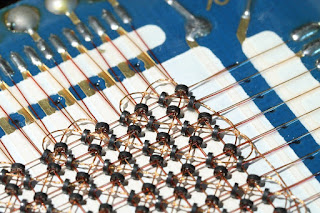Magnetic Core Memory
 |
| Magnetic Core Memory |
Magnetic core memory is a non-volatile random access memory. In 1951 at MIT magnetic core memory was developed. Almost all early computers used the magnetic core as their primary internal memory before the wide availability of semiconductor memory. The basic magnetic core memory cell is a small doughnut-shaped core which was made of a ferromagnetic material. These cores are called ferrite cores. Its diameter is almost 0.05 inch. Here in magnetic core memory, there is a small wire which threaded through the centre of the magnetic core. When a current pulse is passed through in this wire, a magnetic flux is set up in the core in a direction that depends on the direction of the current. Because of the magnetic retentivity of the core, it stays magnetized even after the current pulse is terminated. In other words, it is non-volatile. The two directions of magnetization are used to represent 1 and 0, respectively. Stored data are read from a core by magnetizing it in the 0 direction and using a second threaded wire as a sense wire. The size of the voltage induced in the sense wire will be greater if the core is initially in 1 state rather than 0 state. The reading of a magnetic core memory is said to be destructive since it always leaves in 0 state. Thus, the data can be rewritten after a read operation.
The magnetic core memory system has access times from 100ns to 500ns. It can still be found in some old minicomputers and mainframes. But for all practical purposes, their large physical size and complex interface circuitry have made them virtually obsolete.
0 komentar:
Post a Comment